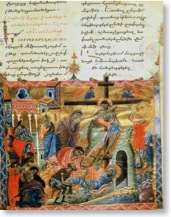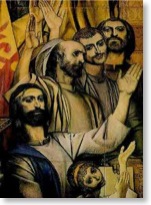THE TRANSLATORS
No review of Armenian language or literature is
complete without considering the legacy of
Armenian translators. If the fifth century is
often described as the Golden Age of Armenian
letters, it is largely due to the
implementation of the Alphabet and the
translation of the Bible into Armenian. Yet,
these events obscures the tradition of
translating that existed before these events
and specially the output that followed the
intellectual and cultural endeavors of
5th
century. It is a fair assessment to state that
the tradition of translating was an ongoing and
uninterrupted process throughout the history of
Armenian literary culture.

A second period of the development of Armenian translation included theoretical works that took precedence over religious texts--dogmatic and philosophical writings related to the needs of contemporary Armenian life and the desire to master the knowledge of ancient philosophers and scientists. During this period the Aphtonius’ Progymnastica, Theon of Alexandria’s Progymnaspata, additional writings of Plato and Aristotle and other works were translated into Armenian, although a significant number of these works were already known to Armenians in their original languages. Gradually, the efforts to identify and translate works of prominent scholars continued over the next millennium that included all areas of knowledge to medieval man--grammar, rhetoric, philosophy, natural science and theology.

At the threshold of the modern era, the seventeenth and eighteenth centuries were dedicated to translating exclusively non-ecclesiastical material being developed in post-Renaissance Europe. The dominant position of the Armenians in the world trade contributed immensely to this cultural exchange, initiated at the beginning of the sixteenth century through the funding of printing and publishing centers in Venice (1512), Marseille or Amsterdam (1511) as well as Calcutta, Singapore and other hubs where Armenian diasporan communities existed.
The legacy of these translators is only a reflection of the vitality of Armenian cultural and literary tradition that tried to keep pace with the new ideas, philosophies and discoveries. This tradition also contributed to the fact that made Armenians one of the first cultures in the East to be fully aware of the changes taking place in the world.
Yet, these endeavors required a tremendous amount of dedication and sacrifices.

We also know that members of both groups in addition to their linguistic talents, they also were learned scholars and experienced researchers who were educated in Constantinople, Athens, Antioch and other cities, and it is safe to assume that they pursued some of their translations in these cities.

Yet, an objective evaluation of the work of ancient and medieval translators transcends the contributions they made to Armenian literary and cultural life. The work and the legacy of this cultural heritage is of great importance for the study of world civilization, since many works written in Greek or Syriac, whose originals are now lost, have been preserved in Armenian versions only and have become a part of the inheritance of contemporary civilization.
Among these works one must mention the Chronicon, in two parts, by Eusebius of Cesarea (died 339) which has come down to us through a fifth century Armenian translation. This work deals with an enormous period of history, from prehistoric times until the beginning of the fourth century AD. It presents in sequence the chronologies of the Assyrian, Babylonian, Egyptian, Hebrew, Median and Persian kingdoms,

Armenian translations have helped to preserve the literary legacy of other renowned patristic writers, such as Athanasius of Alexandria, Severian of Gabala, Eusebius of Emessa, Ephrem Syrus and others.
The above is only a partial enumeration and in no way a comprehensive catalogue or an inventory. Surprisingly, the possibility remains that other works are still unknown to scholarship and extant in not-yet-catalogued Armenian manuscripts that are scattered all over the world (as well as hidden Ottoman/Turkish archives, looted during the annihilation of the Armenians from their historical homeland) may still be discovered. Two recently discovered versions of works whose originals are no longer extant were published in 1957: a theological treatise attributed to Patriarch Eutyches of Constantinople and Faras the Syrian’s Care of Horses, a veterinary work.

Since ancient times, the Armenian church has beatified the “translators”. To this day, the Armenian nation and the church celebrate this special holiday; designated as “Tarkmanchatz Don”--Translators Day-- in the month of October.
Considering their contribution, it is not difficult to understand why.
To have another language is to possess a second
soul.
Charlemagne